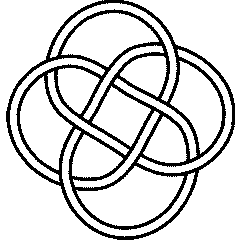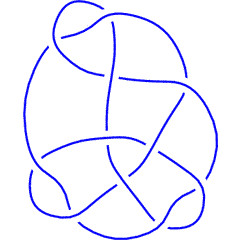The Alexander-Conway Polynomial: Difference between revisions
No edit summary |
No edit summary |
||
| (18 intermediate revisions by 10 users not shown) | |||
| Line 4: | Line 4: | ||
<!--$$?Alexander$$--> |
<!--$$?Alexander$$--> |
||
<!--Robot Land, no human edits to "END"--> |
|||
{{HelpAndAbout| |
|||
n = 2 | |
|||
n1 = 3 | |
|||
in = <nowiki>Alexander</nowiki> | |
|||
out= <nowiki>Alexander[K][t] computes the Alexander polynomial of a knot K as a function of the variable t. Alexander[K, r][t] computes a basis of the r'th Alexander ideal of K in Z[t].</nowiki> | |
|||
about= <nowiki>The program Alexander[K, r] to compute Alexander ideals was written by Jana Archibald at the University of Toronto in the summer of 2005.</nowiki>}} |
|||
<!--END--> |
<!--END--> |
||
<!--$$?Conway$$--> |
<!--$$?Conway$$--> |
||
<!--Robot Land, no human edits to "END"--> |
|||
{{HelpLine| |
|||
n = 4 | |
|||
in = <nowiki>Conway</nowiki> | |
|||
out= <nowiki>Conway[K][z] computes the Conway polynomial of a knot K as a function of the variable z.</nowiki>}} |
|||
<!--END--> |
<!--END--> |
||
{{Knot Image|8_18|gif}} |
|||
The Alexander polynomial <math>A(K)</math> and the Conway polynomial <math>C(K)</math> of a knot <math>K</math> always satisfy <math>A(K)(t)=C(K)(\sqrt{t}-1/\sqrt{t})</math>. Let us verify this relation for the knot [[8_18]]: |
The Alexander polynomial <math>A(K)</math> and the Conway polynomial <math>C(K)</math> of a knot <math>K</math> always satisfy <math>A(K)(t)=C(K)(\sqrt{t}-1/\sqrt{t})</math>. Let us verify this relation for the knot [[8_18]]: |
||
<!--$$alex = Alexander[Knot[8, 18]][t]$$--> |
<!--$$alex = Alexander[Knot[8, 18]][t]$$--> |
||
<!--Robot Land, no human edits to "END"--> |
|||
{{InOut| |
|||
n = 5 | |
|||
in = <nowiki>alex = Alexander[Knot[8, 18]][t]</nowiki> | |
|||
out= <nowiki> -3 5 10 2 3 |
|||
13 - t + -- - -- - 10 t + 5 t - t |
|||
2 t |
|||
t</nowiki>}} |
|||
<!--END--> |
<!--END--> |
||
<!--$$Expand[Conway[Knot[8, 18]][Sqrt[t] - 1/Sqrt[t]]]$$--> |
<!--$$Expand[Conway[Knot[8, 18]][Sqrt[t] - 1/Sqrt[t]]]$$--> |
||
<!--Robot Land, no human edits to "END"--> |
|||
{{InOut| |
|||
n = 6 | |
|||
in = <nowiki>Expand[Conway[Knot[8, 18]][Sqrt[t] - 1/Sqrt[t]]]</nowiki> | |
|||
out= <nowiki> -3 5 10 2 3 |
|||
13 - t + -- - -- - 10 t + 5 t - t |
|||
2 t |
|||
t</nowiki>}} |
|||
<!--END--> |
<!--END--> |
||
| Line 22: | Line 50: | ||
<!--$$Abs[alex /. t -> -1]$$--> |
<!--$$Abs[alex /. t -> -1]$$--> |
||
<!--Robot Land, no human edits to "END"--> |
|||
{{InOut| |
|||
n = 7 | |
|||
in = <nowiki>Abs[alex /. t -> -1]</nowiki> | |
|||
out= <nowiki>45</nowiki>}} |
|||
<!--END--> |
<!--END--> |
||
| Line 27: | Line 60: | ||
<!--$$KnotDet[Knot[8, 18]]$$--> |
<!--$$KnotDet[Knot[8, 18]]$$--> |
||
<!--Robot Land, no human edits to "END"--> |
|||
{{InOut| |
|||
n = 8 | |
|||
in = <nowiki>KnotDet[Knot[8, 18]]</nowiki> | |
|||
out= <nowiki>45</nowiki>}} |
|||
<!--END--> |
<!--END--> |
||
| Line 32: | Line 70: | ||
<!--$$Coefficient[Conway[Knot[8, 18]][z], z^2]$$--> |
<!--$$Coefficient[Conway[Knot[8, 18]][z], z^2]$$--> |
||
<!--Robot Land, no human edits to "END"--> |
|||
{{InOut| |
|||
n = 9 | |
|||
in = <nowiki>Coefficient[Conway[Knot[8, 18]][z], z^2]</nowiki> | |
|||
out= <nowiki>1</nowiki>}} |
|||
<!--END--> |
<!--END--> |
||
| Line 37: | Line 80: | ||
<!--$$Vassiliev[2][Knot[8, 18]]$$--> |
<!--$$Vassiliev[2][Knot[8, 18]]$$--> |
||
<!--Robot Land, no human edits to "END"--> |
|||
{{InOut| |
|||
n = 10 | |
|||
in = <nowiki>Vassiliev[2][Knot[8, 18]]</nowiki> | |
|||
out= <nowiki>1</nowiki>}} |
|||
<!--END--> |
<!--END--> |
||
{{Knot Image Pair|K11a99|gif|K11a277|gif}} |
|||
Sometimes two knots have the same Alexander polynomial but different Alexander ideals. An example is the pair [[K11a99]] and [[K11a277]]. They have the same Alexander polynomial, but the second Alexander ideal of the first knot is the whole ring <math>{\mathbb Z}[t]</math> while the second Alexander ideal of the second knot is the smaller ideal generated by <math>3</math> and by <math>1+t</math>: |
Sometimes two knots have the same Alexander polynomial but different Alexander ideals. An example is the pair [[K11a99]] and [[K11a277]]. They have the same Alexander polynomial, but the second Alexander ideal of the first knot is the whole ring <math>{\mathbb Z}[t]</math> while the second Alexander ideal of the second knot is the smaller ideal generated by <math>3</math> and by <math>1+t</math>: |
||
<!--$${K1, K2} = {Knot[11, Alternating, 99], Knot[11, Alternating, 277]};$$--> |
<!--$${K1, K2} = {Knot[11, Alternating, 99], Knot[11, Alternating, 277]};$$--> |
||
<!--Robot Land, no human edits to "END"--> |
|||
{{In| |
|||
n = 11 | |
|||
in = <nowiki>{K1, K2} = {Knot[11, Alternating, 99], Knot[11, Alternating, 277]};</nowiki>}} |
|||
<!--END--> |
<!--END--> |
||
<!--$$Alexander[K1] == Alexander[K2]$$--> |
<!--$$Alexander[K1] == Alexander[K2]$$--> |
||
<!--Robot Land, no human edits to "END"--> |
|||
{{InOut| |
|||
n = 12 | |
|||
in = <nowiki>Alexander[K1] == Alexander[K2]</nowiki> | |
|||
out= <nowiki>True</nowiki>}} |
|||
<!--END--> |
<!--END--> |
||
<!--$$Alexander[K1, 2][t]$$--> |
<!--$$Alexander[K1, 2][t]$$--> |
||
<!--Robot Land, no human edits to "END"--> |
|||
{{InOut| |
|||
n = 13 | |
|||
in = <nowiki>Alexander[K1, 2][t]</nowiki> | |
|||
out= <nowiki>{1}</nowiki>}} |
|||
<!--END--> |
<!--END--> |
||
<!--$$Alexander[K2, 2][t]$$--> |
<!--$$Alexander[K2, 2][t]$$--> |
||
<!--Robot Land, no human edits to "END"--> |
|||
{{InOut| |
|||
n = 14 | |
|||
in = <nowiki>Alexander[K2, 2][t]</nowiki> | |
|||
out= <nowiki>{3, 1 + t}</nowiki>}} |
|||
<!--END--> |
<!--END--> |
||
Finally, the Alexander polynomial attains <!--$Length[Union[Alexander[#]& /@ AllKnots[]]]$--><!--END--> values on the <!--$Length[AllKnots[]]$--><!--END--> knots known to <code>KnotTheory`</code>: |
Finally, the Alexander polynomial attains <!--$Length[Union[Alexander[#]& /@ AllKnots[]]]$--><!--Robot Land, no human edits to "END"-->551<!--END--> values on the <!--$Length[AllKnots[]]$--><!--Robot Land, no human edits to "END"-->802<!--END--> knots known to <code>KnotTheory`</code>: |
||
<!--$$Length /@ {Union[Alexander[#]& /@ AllKnots[]], AllKnots[]}$$--> |
<!--$$Length /@ {Union[Alexander[#]& /@ AllKnots[]], AllKnots[]}$$--> |
||
<!--Robot Land, no human edits to "END"--> |
|||
{{InOut| |
|||
n = 15 | |
|||
in = <nowiki>Length /@ {Union[Alexander[#]& /@ AllKnots[]], AllKnots[]}</nowiki> | |
|||
out= <nowiki>{551, 802}</nowiki>}} |
|||
<!--END--> |
<!--END--> |
||
Latest revision as of 17:21, 21 February 2013
(For In[1] see Setup)
|
| ||||||||
| ||||
 8_18 |
The Alexander polynomial and the Conway polynomial of a knot always satisfy . Let us verify this relation for the knot 8_18:
In[5]:=
|
alex = Alexander[Knot[8, 18]][t]
|
Out[5]=
|
-3 5 10 2 3
13 - t + -- - -- - 10 t + 5 t - t
2 t
t
|
In[6]:=
|
Expand[Conway[Knot[8, 18]][Sqrt[t] - 1/Sqrt[t]]]
|
Out[6]=
|
-3 5 10 2 3
13 - t + -- - -- - 10 t + 5 t - t
2 t
t
|
The determinant of a knot is . Hence for 8_18 it is
In[7]:=
|
Abs[alex /. t -> -1]
|
Out[7]=
|
45
|
Alternatively (see The Determinant and the Signature):
In[8]:=
|
KnotDet[Knot[8, 18]]
|
Out[8]=
|
45
|
, the (standardly normalized) type 2 Vassiliev invariant of a knot is the coefficient of in its Conway polynomial:
In[9]:=
|
Coefficient[Conway[Knot[8, 18]][z], z^2]
|
Out[9]=
|
1
|
Alternatively (see Finite Type (Vassiliev) Invariants),
In[10]:=
|
Vassiliev[2][Knot[8, 18]]
|
Out[10]=
|
1
|
 K11a99 |
 K11a277 |
Sometimes two knots have the same Alexander polynomial but different Alexander ideals. An example is the pair K11a99 and K11a277. They have the same Alexander polynomial, but the second Alexander ideal of the first knot is the whole ring while the second Alexander ideal of the second knot is the smaller ideal generated by and by :
In[11]:=
|
{K1, K2} = {Knot[11, Alternating, 99], Knot[11, Alternating, 277]};
|
In[12]:=
|
Alexander[K1] == Alexander[K2]
|
Out[12]=
|
True
|
In[13]:=
|
Alexander[K1, 2][t]
|
Out[13]=
|
{1}
|
In[14]:=
|
Alexander[K2, 2][t]
|
Out[14]=
|
{3, 1 + t}
|
Finally, the Alexander polynomial attains 551 values on the 802 knots known to KnotTheory`:
In[15]:=
|
Length /@ {Union[Alexander[#]& /@ AllKnots[]], AllKnots[]}
|
Out[15]=
|
{551, 802}
|







![{\displaystyle {\mathbb {Z} }[t]}](https://wikimedia.org/api/rest_v1/media/math/render/svg/97a786720fa81d7d0cf7400c3ff3f72e892fbc33)

